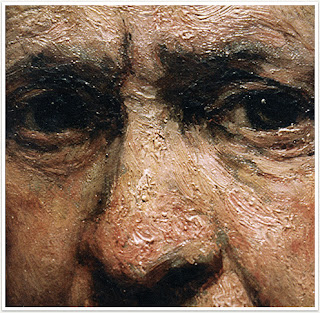Was litharge in earlier paintings, or did Rembrandt just get lucky?
 |
| Rembrandt’s impasto. |
I’m constantly railing about using time-tested technique in your painting. Painters have been experimenting with weird additives in their paints for centuries. The results are often disastrous. Rembrandt van Rijn may be the exception that proves the rule.
Now, 350 years later, we tend to think of Rembrandt as the model of traditional art. That’s especially true since, through most of the 20thcentury, his indirect painting techniques were taught as a sort of ‘purer’ painting in reaction to the volatility of Abstract-Expressionism.
It’s easy to forget that he and his Dutch Golden Agefellows were highly innovative, creating whole new genres of painting and challenging the Baroquestatus quo.
 |
|
Portrait of Marten Soolmans, 1634, is one of three Rembrandt paintings in which plumbonacrite has been found. Courtesy of the Louvre.
|
Rembrandt’s is probably the most-studied technique in art history. We know his palette: lead white, ochre, Cassel earth, bone and ivory char, vermillion, madder lake, yellow lake, lead-tin-yellow and very limited use of azurite and ultramarine blue.
We know that, in his later paintings, he used moody glazes of dark color punctuated by fat impasto passages of pure light, often modeled with a soft brush after they were laid down. These impasto layers were then glazed with color.
 |
|
Susanna and the Elders, 1647, is one of three Rembrandt paintings in which plumbonacrite has been found. Courtesy of the Staatliche Museen zu Berlin.
|
For that he needed a thick, fast-drying white. The danger with that is brittlenesss and cracking. Adding lead and heat-treated oils kept the paint layers more pliable over time. So Rembrandt used a combination of lead white, chalk, and smalt (ground glass). His paintings look great today.
Recently, researchers have found traces of a lead carbonate mineral— plumbonacrite—in three of Rembrandt’s best-known paintings. They’re terrifically excited, because the previously earliest-known appearance of plumbonacrite was in Vincent Van Gogh’s Wheat Stack under a Cloudy Sky (1889).
 |
|
Wheat Stacks under a Cloudy Sky, 1889, Vincent Van Gogh, Kröller-Müller Museum
|
Since lead is cheap and plentiful, it’s been used in paints since antiquity. But it can darken or fade other pigments. In 2015, chemists were trying to figure out what was damaging the red lead pigment in Van Gogh’s picture. In the space between the sample’s reddish-orange Pb3O4 core and the light blue PbCO3 layer that surrounds it, they found plumbonacrite. That was the first time it was ever seen in a pre-20th-century painting.
How did Rembrandt manage to get plumbonacrite into his paintings two centuries before it came into common use? “[O]ur research shows that its presence is not accidental or due to contamination, but that it is the result of an intended synthesis,” wroteVictor Gonzalez of the Rijksmuseum and Delft University of Technology.
 |
|
Bathsheba at her Bath, 1654, is one of three Rembrandt paintings in which plumbonacrite has been found. Courtesy of the Louvre.
|
Their best guess is that it came from litharge, which is an oxide of lead used to refine silver. In the seventeenth century litharge was made by pumping a set of bellows to send very hot air across molten lead, creating the oxide and sending it flying into a nearby receptacle. If this sounds dangerous, it is.
Litharge did create some pretty colors. Litharge of gold is litharge mixed with red lead, which may have been how Van Gogh acquired it. Litharge of bismuth is a brownish silver color—just the kind of color that would appeal to Rembrandt, in fact.
Why would Rembrant have even considered adding litharge to his paint? The most obvious possibility is that it was in use all along, and appears in other, earlier paintings that scientists haven’t examined yet. Or, Rembrandt was messing around and got lucky.
